Holiday in Tahiti – Part 2
Having returned to Tahiti, Caesar, Nick and Jill have begun the task of reclaiming their boat from Mother Nature’s grasp. Last week we saw them scrubbing away algae, wiping away mould, and chipping away rust. But there was much more to be done before the skipper would allow the family to put to sea.
REPLACE THE ANCHOR WINDLASS
This was the biggy. This was the thing which kept us chained, quite literally, to the seabed in Tahiti when we would much rather have been checking out some other, more scenic Pacific island.
Our old anchor winch was built by Nick when we first launched the boat in 2000. A magnificent machine constructed from several, huge cast iron cogs, it could only be operated by hand – and it was for this reason that Caesar had never liked it. To be fair, it’s been a very long time since I weighed anchor, so my vote counted for very little in this matter, but I pointed out that we had specifically chosen to fit a manual windlass on Mollymawk because we had an electric one aboard our previous boat, Maamari. That electric windlass almost never worked. We were forever having to bypass it and take warps to the genoa winch. So, why repeat the mistake? But Caesar was not convinced.
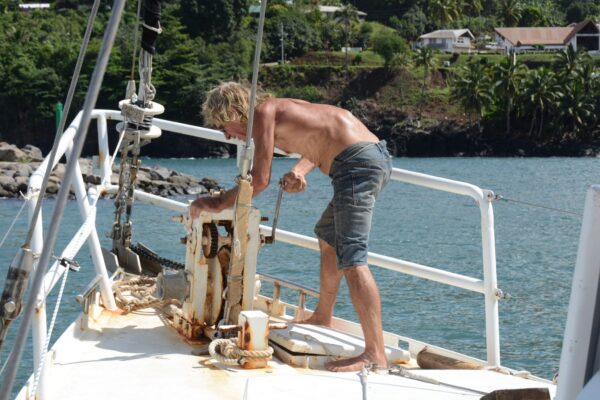
Upon our arrival in Tahiti, two years before, we had happened to come upon a second-hand electric windlass, salvaged from a wreck. It was the perfect size for us, and so we hastily bought it. Now, on our return, we found that Nick’s wonderful old monster was terribly rusted. It wasn’t going to be a case of chipping it and painting it, because I could see that the hammer was going to simply smash the framework to pieces. Caesar therefore wanted to fit the new windlass. But I wanted to forget about either of them; I just wanted to get the chain and anchor up, somehow, when the time came, and thereafter, for our journey onward across the Pacific, we could anchor on rope.
Caesar wouldn’t hear of this.
“But it’s going to take you a month to shift the old windlass and fit the new one,” I wailed.
“Rubbish!” said he. “Four days. A week at most. It’s an easy job.”
Like father, like son. But, in this case, Nick agreed with me; he wanted to keep his rusty rustic windlass. Nevertheless Caesar was the captain now, and a boat is not the place for a democratic decision. Aboard a boat, the word of the captain is law.
The project was as follows:
Grind the old windlass off the deck.
Make good the damage, by welding on a new plate and cleaning and painting the old metalwork around about, as necessary. (This was the part which too the most time.)
Position the new windlass which, meanwhile, during the deck preparations, had to be disassembled, cleaned and serviced, reassembled, and abundantly painted. (The winch is aluminium and the deck is steel; and never the twain must meet or else the winch will dissolve.)
Drill bolt holes and fit the new windlass to the deck using copious amounts of sikaflex and big, carefully isolated, stainless-steel bolts.
Fit the spurling pipe, having cut a hole in the deck in the appropriate place.
Run the (extremely expensive) heavy-duty wires from the winch, through the deck, to the newly-crafted switch panel and the charging battery newly installed on a dedicated, lovingly hand-painted shelf in the forepeak bilge. I’m looking forward to the day when Caesar decides to revamp my cabin, because he certainly does a first class job. But right now I’d have settled for a really crappy, fast job. I just wanted to go sailing!
Needless to say, the project was not accomplished in a week. “There! I said it would take a month!”
“It didn’t,” said Nick. “It took six weeks.”
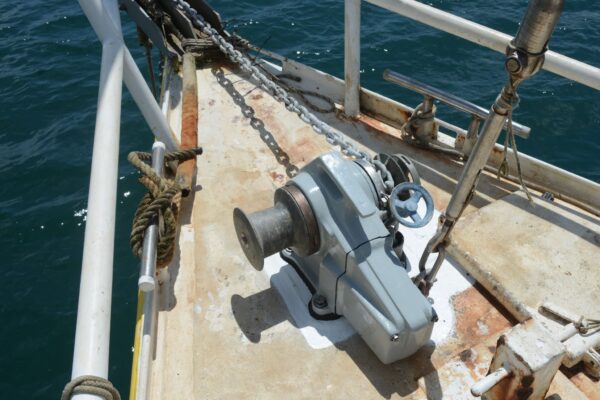
By now, Christmas had been and gone unnoticed. We were working flat out every day of the week, rising at six and getting started by seven and never stopping until it was dark. And still it looked as if the boat would never be ready for us to leave Tahiti.
While diving on the boat to clean the bottom, Caesar found that the anodes (which he had previously thought to be fine) had actually all but disappeared. One more job to add to the list. Fortunately we had a spare set of anodes aboard.
MAST WORK
The new rope having been bought, to replace the rotten stuff, we were now able to fit halyards and sheets. And then, as soon as we had halyards, Nick went aloft to check the rigging. A couple of shackles were renewed and some new paint was applied to the cap in a place where, mysteriously, it had begun to rust. I feel I must give a plug for International paints. Our main-mast hasn’t been repainted since the boat was launched, 23 years ago, and yet, with the exception of this patch on the cap, the paintwork is still entirely sound. (We used Interzinc, Intertuf, Interguard, and two coats of grey Interthane. Frighteningly expensive but definitely worthwhile.)
The only other thing which needed doing aloft was the re-riveting of part of the mast track on the mizzen mast.
MEND THE DINGHY
This was my job, and, as such, it didn’t really hamper our progress except to the extent that I occupied the entire aft deck for over a week. Our antique Avon was already giving us trouble before we took our two year sabbatical, and its tanks now leaked so badly that the for’ard section would completely deflate during the row ashore. Either we had to mend it, somehow, or else we had to invest about 3,000 Euros in a new but very cheaply made thing which wasn’t even of the type that we wanted.
“Why can’t we just use the old bath toy?” I suggested, but the skipper was having none of that. The ‘bath toy’ (an Avon Redstart which was first used aboard the Ark) is a bit of a tight fit for three adults.
The ‘bath toy’ had spent much of its life in my father-in-law’s garage and its more recent years in our lazarette, and so it was in pristine condition, whereas the Neolithic-age ‘rubber dubby’ which accommodates the entire family and a week’s shopping, looks like the sort of thing you’d find in a skip. It’s had a hard life full of adventures.
Nick had tried many times to mend the poor old dingo with various glues, but nothing would stick to the tired old hypalon. We were just about to bin the thing – Nick was literally just about to take it ashore and dump it – when I said, “Oh, for Pete’s sake! Lets just have one more ‘very last try’ before we throw away three grand on something that we don’t even like.”
I then spent a week smothering the holes with Sika 291i. Two weeks later, the boat is still holding air, and although I don’t see it lasting for long, it’s good enough to get us to a place where the dinghies are affordable and of a reasonable quality.
Just a few days after I’d finished the job, a very nice Danish family popped across to see us in their as-new but rather soggy inflatable. “We’ve punctured our dinghy,” they announced.
“Oh no,” thought I, “They’re going to ask me to mend it.”
But it turned out that they’d already bought another boat and were just donating the damaged one to us. Yipee-i-ay!
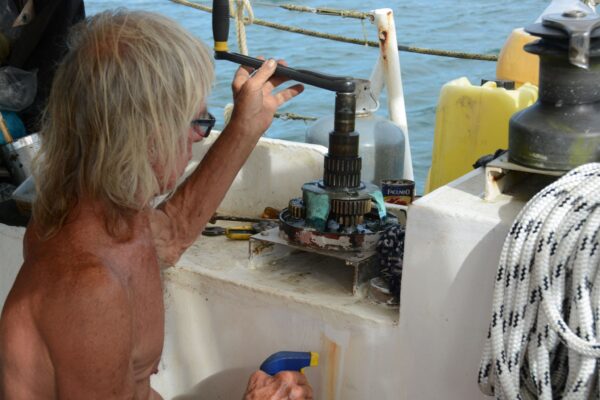
REPAIRS TO THE SELF-STEERING RUDDER
Once the dinghy was out of the way I could begin work on the self steering rudder. We’d very cleverly brought this aboard during our absence, so that it wouldn’t become covered in weed. Instead, it split open in the hot sun. So I had to chisel out the cracks in the wood and, with Caesar’s help, pour epoxy into them. Then the work of art had to be sanded and painted with our DIY ‘copperbot’; or rather, I did the after half with pure, spherical copper in epoxy and I did the leading edge with copper oxide.
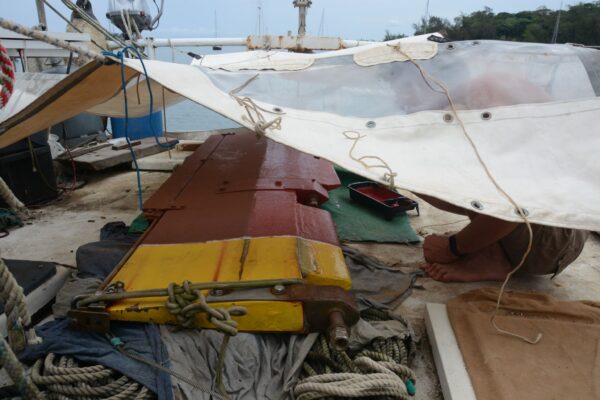
A NEW HELMSMAN’S SEAT
Caesar had only just built us a new helmsman’s seat four years before, while we were in Chile. It was a beautiful thing, made of a nice yellow-coloured hardwood and oiled; and it should never have been left on deck. On our return it was so rotten that it was powdery in places.
I have to say that wood is not the best material for the tropics. Not only does it rot (and it rots far faster than steel rusts), it is also prone to attack by hungry termites. During our stay in Tahiti we met several people whose wooden cabins had been devoured by termites and one whose plywood hull had been eaten, so that the boat nearly sank when the owner was away for six months.
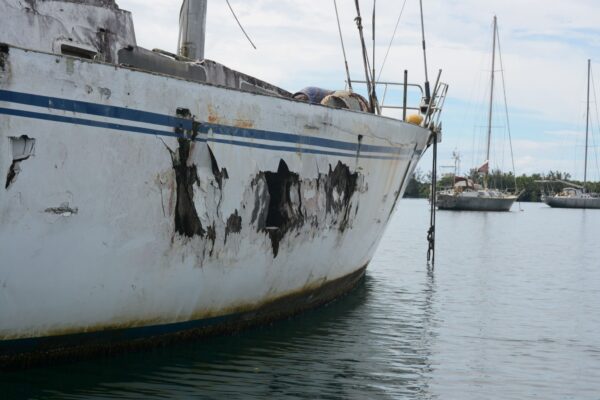
The boys would have been happy to set sail without building a new helmsman’s seat, but this time I was the one who insisted that the job be done. “If you think I’m going to stand at the wheel… Well, I’m not!”
“You always used to. We didn’t even have a seat for the first four or five years. You once stood at the helm for ten hours straight when the self steering broke.”
“Yes, but my knee joints were 20 years younger in those happy days.”
So they duly bought some planks, and Caesar crafted a seat. And he insisted upon applying the three protective layers of epoxy which the previous seat had lacked, but I was allowed to do the topcoat, using International’s deck paint – pale blue paint, exactly the same as I painted on the canvased decks of my old clinker boat some 35 years ago.
“The only difference is that it’s now six times the price.”
FRAMEWORK FOR THE SOLAR PANELS
During our absence the termites had entirely eaten the bamboo framework supporting the solar panels, and the panels had fallen on deck. Likewise, the little bastards had also eaten the various lengths of nice green bamboo that we’d gathered in the Marquesas with the idea of making a boom for the dinghy and various other things. I’d always assumed that bamboos were safe to use if you could get them aboard while they were still green – but termites can fly. On our very first evening back on the boat, they rained down upon us, and although at that time we didn’t even know what they were, we knew enough to panic. The little creatures scattered tiny cellophane wings everywhere and ran around like manic ants; so we ran around shutting the hatches. We’re hoping we didn’t bring any below decks on our clothes, but just to be on the safe side, I’m inclined to think that we should sail south till we reach a climate where termites can’t survive. Otherwise, I fear they will eat the whole cabin.
“How about Antarctica? I’m sure they don’t have termites there.”
Caesar finished the final lashings on the solar panel framework in the dark on the night before we cleared out of French Polynesia. After three solid months of hard graft and not one single day of fun, Mollymawk is finally up to scratch and we can finally set sail. (No, not to Antarctica…) I have to say that we would not be leaving quite yet if we had any choice – but we don’t. We have a couple of week’s worth of work which we’d really like to do before throwing ourselves out onto the ocean, but our time here is up. Our trees, back in Iberia, are calling out to us – the trees, the chickens, the cats, and our friends are all tugging at my heartstrings now, just as Mollymawk was tugging at them when we were over there, on the other side of the world… But it’s not just that. More importantly, our visa is up and our boat’s permit is finished, too. Red tape is driving us out to sea; out on a journey of 4,000 miles…
By the time you read this article, Mollymawk should be well underway. If we make it to the other side of the vast blue, not so very pacific pond, we’ll let you know!
